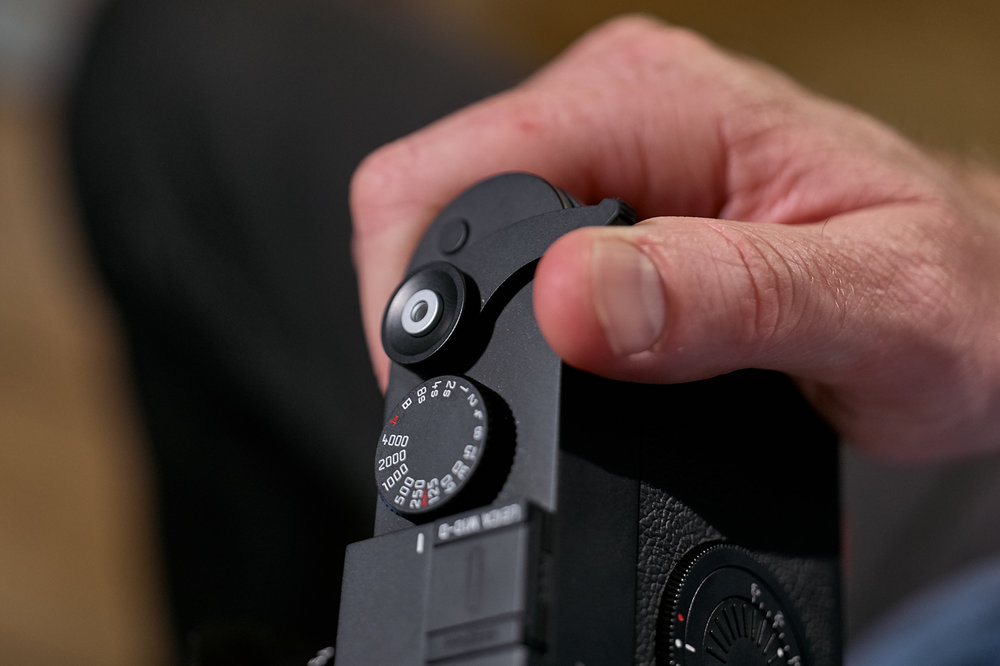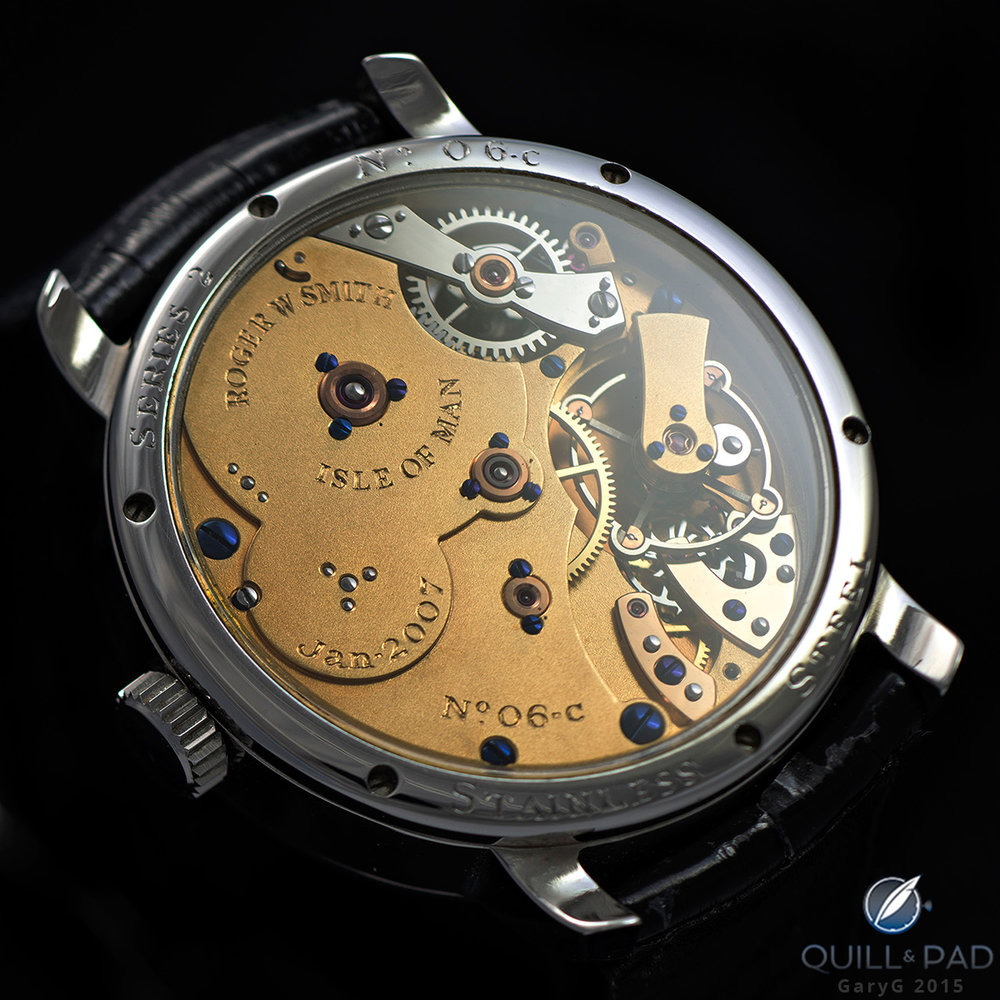
So, contrary to tourbillons, minute repeaters, and chronographs, the automatic winding mechanism became mechanism non grata for ultra-fine watches. The spectacular finishing and extreme complexity of the movements and their complications could not be covered up by something else. Every rule has its exceptions, but it is remarkable how many high-end timepieces opt for manual winding over automatic winding and how many collectors prefer this for haute horlogerie.
Joshua Munchow, writing for the wonderful Quill & Pad Watch site, relates how purists of fine horology eschew the undoubted benefits of automatics in favour of manual winding.

What has this to do with cameras, you might ask? Well, to some extent this forms an analogy with the Leica M rangefinder. By rights the mechanical rangefinder it should have died off ten years ago; and it might well have done so if there had not been such an enthusiastic following among people with a shelf-full of manual-focus lenses. And a few bob to spare, it must be added.
Yet….. why buy a hobbled digital camera when you can lay your hands on a camera offering all the electronic aids you could wish for, and a control panel to satisfy a fighter pilot?
As most of us appreciate, there is a lot of fun in manual focus. And, if you are going to focus manually, I can make a strong argument for the supremacy of the mechanical split image over all the modern aids, such as focus peaking and magnification. Sure, both have their advantage. A modern EVF is helpful with “difficult” lenses such as the Noctilux or the 50mm Summilux, but, by and large, manual focus with an M camera is quick, efficient and precise. I am so wedded to the concept of centre-focus and recompose that I use it most times on digital cameras with electronic viewfinders. I just find it easier to select the subject, focus and then recompose the picture.
But we could go further. Surely, the M10-D is the epitome of purity in camera design. As a rangefinder experience it is impressive, with absolutely no electronic distractions.
Others (yes, David B) will disagree. Even I can disagree with myself when I have a Lumix G9 or, even, a D-Lux 7 in my hands. But perhaps Joshua’s commentary on the world of horological connoisseurs has a parallel in the photographic world.
As Joshua concludes:
The routine of winding a watch can be just as satisfying as walking your dog or sleeping in your own bed.
What’s your view? The M10-D is nothing if not controversial. Is it like walking your dog? Should it be regarded as the Leica connoisseur’s ideal camera? Discuss.


I’m a baby boomer. Analog has its pleasures. Tactile is nice. I like my mechanical auto wound watch and my antique car with its manual drum brakes and manual steering with kingpin front end. But my modern Audi is more useful.
I like my M10, but would buy an M with an integrated EVF like my CL in a heartbeat, especially if it was lighter weight than the M10. But I appreciate my M10 – I sold my almost new Sony a7riii because the circus of menus dials and buttons got in the way of my experience.
(FWIW, I have a mechanical watch, two antique cars, two turntables and assorted Macintosh gear – my boomer cred is strong)
I’m a big fan of hand-wound watches as it is a) a tactile experience b) those watches tend to be made with a great deal of care. Look at Roger Smith’s watch and you can see the finishing is absolute perfection, even if it’s not particularly decorated. You don’t buy these pieces for accurate timekeeping but for the visceral experience. I still miss manual winding my camera from the days of film…
Nothing is as gorgeous as a Purdy side by side!
While I like to see dry stone walling and other traditional activities and expertise – old codgers driving steam traction engines, steam railway engines, and ancient diesel marine motors like Gleniffers, Kelvins and Gardners – watchmakers’ intricacies don’t really set me on fire any more than navigating by sextant instead of GPS.
I like a watch which shows me what I want to know, rather than having a glass behind (..oh, beg pardon; ‘sapphire crystal’..) so that I can see the escapement and the tourbillon.
I’m wearing a cheap – £9.99 delivered! – ‘MDC’ Infantry-brand watch ..oh, I see the price has gone up to £11.99 delivered! – https://tinyurl.com/MDCInfantry ..and yes, it’s quartz, no it’s not mechanical, yes it has the day, and yes it has the date.
No, it doesn’t need winding, no it doesn’t need wrist-shaking to auto-wind, no it doesn’t need putting on its Apple Watch charger every night, and no, it doesn’t tell me what incoming messages I have.
But, in the words of Steve Jobs, “..it just works”. And I like the look of it.
But a hand-wound watch is like a manually-focused electronic M10-D..? Er, really?
And, really, “..the M10-D is the epitome of purity in camera design”..?!
No, I’d say a Quality Street biscuit tin with a little hole in the side and a piece reversal photo-sensitive paper facing it inside the tin (..like the paper in those ‘Photo-Me’ booths..) is “the epitome of purity in camera design”. You can’t get much simpler.
An M10-D has a complicated viewfinder full of semi-reflective prisms, metal cut-outs, cranks and levers, battery-powered amplifier(s), CMOS circuitry, teeny-weeny lenses over all those teeny-weeny photosites ..it is BASIC though, for an electronic camera, I’ll give you that.
But I choose ‘useful’ over basic. [The only reason I use an M10(-P) is that I have a cupboard full of Leica(-fit) lenses. (But I do often put them on a Sony A7RMkII, with a Techart auto-focus adaptor.)]
I have a useful car, which is comfortable and smooth, and holds an extra 4 (at a pinch) (..or three extra in comfort). I don’t drive a basic – or should I say “essence of purity”? – Ford 100E, or Ford Model T. Well, not any more. (The Ford 100E.)
I don’t use an abacus for counting, and I don’t pay for my Tube ticket with cowrie shells, shillings or groats and farthings.
When one imagines “the purest” of equipment, or methods, there’s always something “purer” still. An M10-D “pure”? ..no; an M3, surely ..no; a Box Brownie ..no; wet plate collodion ..no; Daguerrotype! ..At some point there’s a “convenience” cut-off, and purists say “I don’t want to go more inconvenient than THAT!”
Purest form of writing? Look at my Sheaffer ..no, look at MY Waterman ..NO! Look at my QUILL! ..You use a quill?! ..I carve my name in marble with a chisel!
The choices of “purest” are all just arbitrary.
“the Leica connoisseur’s ideal camera?” ..why not just be done with it – and choose the M1 or original MD? ..You know; the one with no light meter, no screen to see what you’ve shot ..and no viewfinder. Basic? “Pure”? Sure. But useful? No.
(Oh, and Dave, below: the pictures you get with a M10-D are not, I find, in some magical way, ‘better’, or more desirable, than those from any other brand of modern camera. It’s the “possession” of the piece of hardware you’re after, in lusting for an M10-D, not its results ..your Nikon Df beats it in practical use in every possible way!)
I have to say that last night, being a rare occasion of being home from work early, I saw David Suchet on TV with his Grandfathers Leica M3 – and it did look a piece of equistive machinery. He even joked about only having 36 shots in it unlike its digital bretherens.
I do though, like the idea of the M10-D as I am sure most on here would already know. If only I had the cash for one, or Leica would loan me one for a few weeks so I could write about the experience. I can only dream. One day it will all come good.
Many years ago back in the early 80’s I worked with Peter Suchet, brother of David (actor) and John (newscaster in UK) and was given the story of how their grandfather James Jarche had captured the first public images of Wallace Simpson and David (future Edward VIII) on film as they were out to dinner on a Leica. That sparked my interest in Leica and now own a CL as a consequence.
Well said William!
The M10-D is not a fully mechanical camera with its electronic shutter etc and, as you say, the ‘wind lever’ is not a wind lever. There is a degree of conceit about the design, but Leica would not have produced the camera unless there was a market for it. The purest mechanical production Leica, and the nearest analogue to the watch shown above, was the I Model A from 1925. If you like a bit of rangefinder in the mix you can throw in the II Model D from 1932 and the M3 from 1954. All subsequent Leica LTM and M cameras just added to those basic designs. The most that can be said about the M10-D is that it is slightly closer to the M3 heritage than the M10, but the M-A is closer.
William